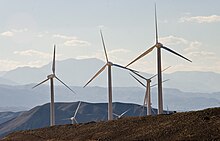ஈரானில் காற்றாலை சக்தி

ஈரானில் காற்றாலை சக்தி (Wind power in Iran) மூலம் மின்சாரத்தை உற்பத்தி செய்ய நடவடிக்கைகள் மேற்கொள்ளப்பட்டு வருகிறது. நாடு முதன்மையாக நம்பியிருக்கும் புதைபடிவ எரிபொருட்களுக்கு மாற்றாகக் காற்றாலை சக்தி கருதப்பட்டு முதலீடுகள் செய்யப்படுகின்றன.
சதீத் தொழிற்சாலை குழுமம் எனப்படும் ஈரானிய உற்பத்தி நிறுவனம், மற்றும் முதலீடுகள் மற்றும் இந்திய சுல்சோன் ஆற்றல் நிறுவனம், செருமன் காற்றாலை விசையாழி நிறுவனங்களின் வளங்கள் ஆகியவற்றின் உதவியுடனும் முதலீடுகளுடனும் ஈரானால் வலுவான மற்றும் நிலையான காற்றாலை துறையை உருவாக்க முடிந்தது. 2004 ஆம் ஆண்டில் ஈரான் காற்றாலை மூலம் 25 மெகாவாட்களையும், 2005 ஆம் ஆண்டில் 32 மெகாவாட்களையும், 2006 ஆம் ஆண்டில் 45 மெகாவாட்களையும் மட்டுமே உற்பத்தி செய்தது. 2009 ஆம் ஆண்டில் மொத்த காற்றாலை திறன் 130 மெகாவாட்டை எட்டியது. கிலான் மாகாணத்தின் மஞ்சீல், இரசாவி கொராசன் மாகாணத்தின் பினலூட்டு போன்ற ஈரானின் கடலோர மற்றும் காற்று வீசும் பகுதிகளில் பெரிய காற்றாலைகள் உற்பத்தி செய்யப்பட்டதே இதற்கான காரணமாகும்.[1][2]
மேற்கோள்கள்[தொகு]
- ↑ "Iran to construct 2000 MW in renewable energy capacity, much from biomass : Biomass Digest - biofuels, biodiesel, ethanol, algae, jatropha, green gasoline, green diesel, and b..." Archived from the original on 2010-02-03. பார்க்கப்பட்ட நாள் 2022-05-10.
- ↑ IR : Iran Announces New Renewable Energy Facilities - General news news
- F., F., N., S., S., S., & M.A., R. (2015). Assessment of wind energy potential and economics in the north-western Iranian cities of Tabriz and Ardabil. Renewable and Sustainable Energy Reviews, v45, 87-99.
- Fatemeh Rahimzadeh Affiliation: Atmospheric Science and Meteorological Research Center (ASMERC), T. I., & Affiliation:, A. M. (2011). Wind speed variability over Iran and its impact on wind power potential: a case study for Esfehan Province. Meteorological Applications, v18 n2, 198-210.
- Gholamhassan Najafi Affiliation: Tarbiat Modares University, P. B.-1., & Barat Ghobadian Affiliation: Tarbiat Modares University, P. B.-1. (2015). LLK1694-wind energy resources and development in Iran. Renewable and Sustainable Energy Reviews, v15 n6, 2719-2728.
- Julien Mercille Affiliation: School of Geography, P. a., & Alun Jones Affiliation: School of Geography, P. a. (2009). Practicing Radical Geopolitics: Logics of Power and the Iranian Nuclear “Crisis”. Annals of the Association of American Geographers, v99 n5, 856-862.
- Kasra Mohammadi Affiliation: Department of Mechanical and Industrial Engineering, U. o., Ali Mostafaeipour Affiliation: Industrial Engineering Department, Y. U., & Affiliat, A. S. (2009). Application and economic viability of wind turbine installation in Lutak, Iran. Environmental Earth Sciences, v75 n3, 1-16.
- Sayed Moslem Mousavi Affiliation: Sharif University of Technology, I., & Morteza Bagheri Ghanbarabadi Affiliation: Sharif University of Technology, I. (2015). The competitiveness of wind power compared to existing methods of electricity generation in Iran. Energy Policy, v42 (201203), 651-656.
- Wyn Q Bowen Affiliation: Defence Studies Department, K. C., & London, J. K. (2004). The Iranian Nuclear Challenge. International Affairs, v80 n2, 257-276.
புற இணைப்புகள்[தொகு]
- Renewable Energy Organization of Iran பரணிடப்பட்டது 2010-11-30 at the வந்தவழி இயந்திரம்

